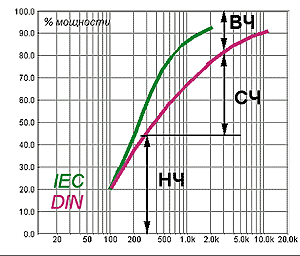It turned out that the spectrum of "Races" performed by Yello almost without deviation repeats spectrum of pink noise standard uniform energy distribution. So the value of this entry to test the audio is not just confirmed, and got (almost by accident) scientific justification.
Such a tool will be in ANY audio system to play at least two speakers in each channel.
However, in General, science is not far away from reality on the part of the spectrum, and therefore the standard curves can be used as the basis of such essential, in all respects, factor in the design of car audio systems, power distribution frequencies bands. This is most critical for automotive applications where per-channel amplification - thing is not exotic. To the right of "Yello" - curve recommended power distribution by frequency channels based on the "old" and "new" standard curves of the musical spectrum.

"Races" Yello - sample uniform spectrum.

Power distribution frequencies bands with an ideal filtration.
Graph - it is working and practical. To use it just: mark frequencies of signal LF, MF and HF (in our example 300 Hz and 3 kHz). The ordinate of the first border section will show the percentage of power per WOOFER channel, between the frequencies of section LF/MF and MF/HF on the midrange, and the rest - power RF channel as a percentage of total. For dual band system procedure, of course, even easier.
To a point on the chart and recommendations were given for valid standard IEC/DIN (purple), and departed to the region of the legends of the old IEC (without DIN). The old standard was that when the frequency of signal 2 kHz and above, the share of RF channel accounts for 5 percent of total capacity. Modern, hippy curve at the same frequency partition on HF is proposed that 20 percent of capacity, not less. Both, be careful, rightly assuming perfect separation of the strips, i.e. the separation filters infinitely large slope, so that each channel will get only due to him part of the spectrum. In real terms that it is not, and depending on which filters are applied, the channels will get more or less than other frequencies. And they follow the curve of spectral distribution, so the result is not so obvious as it would be if instead of music we listened to pink noise. What happens, we will illustrate, take a ride on the works of our eminent and experienced colleagues.
Literature
- The Magazine "Car Audio" No. 11 / 2000
Author: Andrew Elyutin; Publication: www.avtozvuk.com, www.cxem.net






